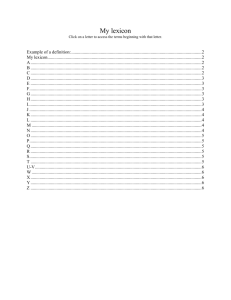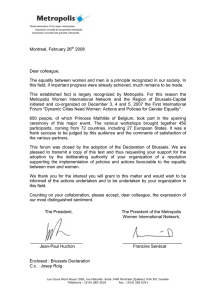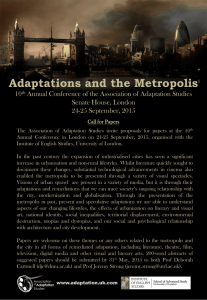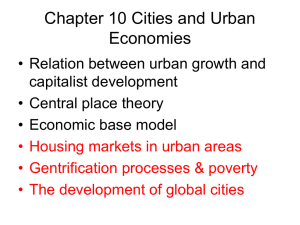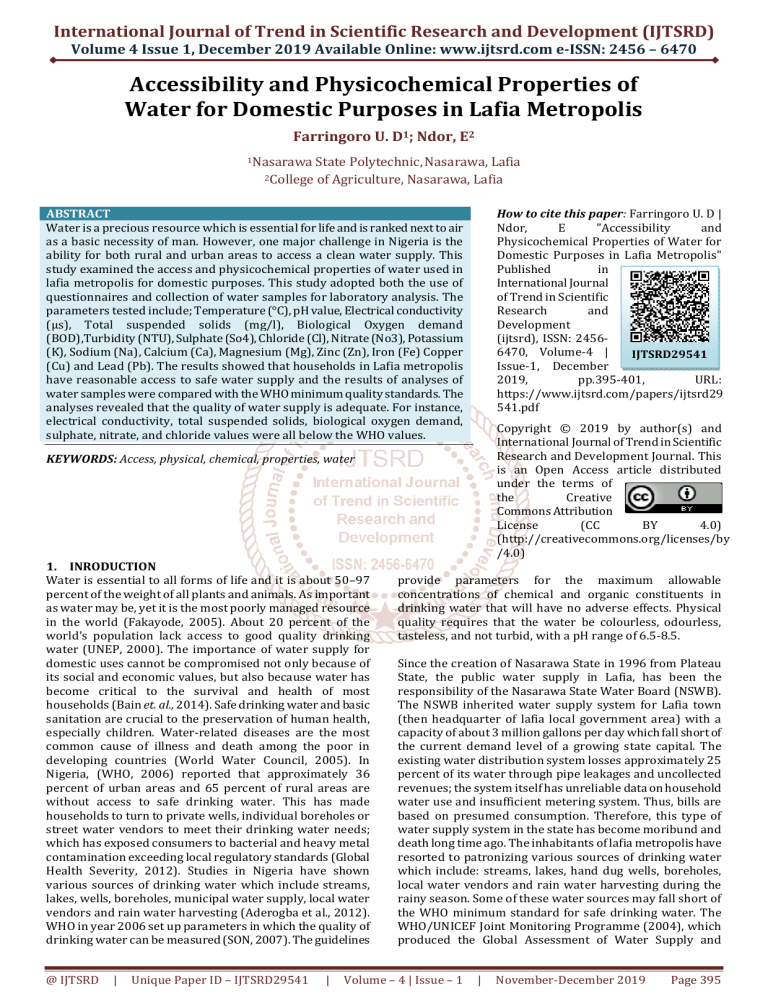
International Journal of Trend in Scientific Research and Development (IJTSRD)
Volume 4 Issue 1, December 2019 Available Online: www.ijtsrd.com e-ISSN: 2456 – 6470
Accessibility and Physicochemical Properties of
Water for Domestic Purposes in Lafia Metropolis
Farringoro U. D1; Ndor, E2
1Nasarawa
2College
State Polytechnic, Nasarawa, Lafia
of Agriculture, Nasarawa, Lafia
How to cite this paper: Farringoro U. D |
Ndor,
E
"Accessibility
and
Physicochemical Properties of Water for
Domestic Purposes in Lafia Metropolis"
Published
in
International Journal
of Trend in Scientific
Research
and
Development
(ijtsrd), ISSN: 24566470, Volume-4 |
IJTSRD29541
Issue-1, December
2019,
pp.395-401,
URL:
https://www.ijtsrd.com/papers/ijtsrd29
541.pdf
ABSTRACT
Water is a precious resource which is essential for life and is ranked next to air
as a basic necessity of man. However, one major challenge in Nigeria is the
ability for both rural and urban areas to access a clean water supply. This
study examined the access and physicochemical properties of water used in
lafia metropolis for domestic purposes. This study adopted both the use of
questionnaires and collection of water samples for laboratory analysis. The
parameters tested include; Temperature (°C), pH value, Electrical conductivity
(μs), Total suspended solids (mg/l), Biological Oxygen demand
(BOD),Turbidity (NTU), Sulphate (So4), Chloride (Cl), Nitrate (No3), Potassium
(K), Sodium (Na), Calcium (Ca), Magnesium (Mg), Zinc (Zn), Iron (Fe) Copper
(Cu) and Lead (Pb). The results showed that households in Lafia metropolis
have reasonable access to safe water supply and the results of analyses of
water samples were compared with the WHO minimum quality standards. The
analyses revealed that the quality of water supply is adequate. For instance,
electrical conductivity, total suspended solids, biological oxygen demand,
sulphate, nitrate, and chloride values were all below the WHO values.
Copyright © 2019 by author(s) and
International Journal of Trend in Scientific
Research and Development Journal. This
is an Open Access article distributed
under the terms of
the
Creative
Commons Attribution
License
(CC
BY
4.0)
(http://creativecommons.org/licenses/by
/4.0)
KEYWORDS: Access, physical, chemical, properties, water
1. INRODUCTION
Water is essential to all forms of life and it is about 50–97
percent of the weight of all plants and animals. As important
as water may be, yet it is the most poorly managed resource
in the world (Fakayode, 2005). About 20 percent of the
world’s population lack access to good quality drinking
water (UNEP, 2000). The importance of water supply for
domestic uses cannot be compromised not only because of
its social and economic values, but also because water has
become critical to the survival and health of most
households (Bain et. al., 2014). Safe drinking water and basic
sanitation are crucial to the preservation of human health,
especially children. Water-related diseases are the most
common cause of illness and death among the poor in
developing countries (World Water Council, 2005). In
Nigeria, (WHO, 2006) reported that approximately 36
percent of urban areas and 65 percent of rural areas are
without access to safe drinking water. This has made
households to turn to private wells, individual boreholes or
street water vendors to meet their drinking water needs;
which has exposed consumers to bacterial and heavy metal
contamination exceeding local regulatory standards (Global
Health Severity, 2012). Studies in Nigeria have shown
various sources of drinking water which include streams,
lakes, wells, boreholes, municipal water supply, local water
vendors and rain water harvesting (Aderogba et al., 2012).
WHO in year 2006 set up parameters in which the quality of
drinking water can be measured (SON, 2007). The guidelines
@ IJTSRD
|
Unique Paper ID – IJTSRD29541
|
provide parameters for the maximum allowable
concentrations of chemical and organic constituents in
drinking water that will have no adverse effects. Physical
quality requires that the water be colourless, odourless,
tasteless, and not turbid, with a pH range of 6.5-8.5.
Since the creation of Nasarawa State in 1996 from Plateau
State, the public water supply in Lafia, has been the
responsibility of the Nasarawa State Water Board (NSWB).
The NSWB inherited water supply system for Lafia town
(then headquarter of lafia local government area) with a
capacity of about 3 million gallons per day which fall short of
the current demand level of a growing state capital. The
existing water distribution system losses approximately 25
percent of its water through pipe leakages and uncollected
revenues; the system itself has unreliable data on household
water use and insufficient metering system. Thus, bills are
based on presumed consumption. Therefore, this type of
water supply system in the state has become moribund and
death long time ago. The inhabitants of lafia metropolis have
resorted to patronizing various sources of drinking water
which include: streams, lakes, hand dug wells, boreholes,
local water vendors and rain water harvesting during the
rainy season. Some of these water sources may fall short of
the WHO minimum standard for safe drinking water. The
WHO/UNICEF Joint Monitoring Programme (2004), which
produced the Global Assessment of Water Supply and
Volume – 4 | Issue – 1
|
November-December 2019
Page 395
International Journal of Trend in Scientific Research and Development (IJTSRD) @ www.ijtsrd.com eISSN: 2456-6470
Sanitation data, describes reasonable access to water supply
as ‘the availability of at least 20 liters of water per person
per day from a source within one kilometer of the user’s
dwelling’. In addition, access to potable water supply also
means ‘having access to safe drinking water with microbial,
chemical and physical characteristics that meet the WHO
guidelines’. Therefore, the objective of this study was to
investigate the general access of households to safe, potable
and qualitative drinking water in Lafia metropolis
8° 24' 17" North. Lafia town is the Headquarter of Lafia Local
Government with a land area of 2,797.5 sq. Km (Fig. 2). Lafia
town is situated on Longitudes 08º 30¹ East and Latitude 08
º 31¹Nnorth. The area is located in the middle belt. It is
generally very warm and humid with dry and rainy seasons.
It has a mean temperature range of 26 º C to 30 º C, a mean
rainfall of 1120mm to 1500mm relative humidity of 60-80%
and falls within the guinea savannah kind of vegetation;
(NIMET, 2018).
2. MATERIALS AND METHODS
2.1. The study area
Nasarawa State is bordered by Kaduna, Kogi, Benue, Taraba
and Plateau States as well as the Federal Capital Territory
(FCT) Abuja. The State consists of Thirteen (13) Local
Governments (see Fig.1) and has an estimated land area of
27, 107.8 sq. Km with Longitude 8° 08' 38" East and Latitude
2.2. Structure of Lafia Metropolis and Population
Lafia metropolis consists of three (3) structural units
distinguished in terms of age of building as
well as density of physical development and population.
These structural units are: the old town area, Sabon pegi
area, and Millionaires/Bukan sidi/ Tudun Gwandara area.
The population of the metropolis is 267,546 (NPC, 2006)
Figure1: Map of Nigeria Showing Nasarawa State
Figure2: Map of Nasarawa State Showing Lafia Local Government Area
2.3. Topography and Drainage
Lafia town and its surrounding settlements are within the
Mada River Basin of the Benue valley platform. The area is
largely an undulating plain which is drained by River Mada
and its tributaries and by some tributaries of Guma and
Ankwe Rivers emptying into the Benue River.
@ IJTSRD
|
Unique Paper ID – IJTSRD29541
|
2.4. Research Design
This study adopted both the use of questionnaires and
collection of water samples for laboratory analysis. This was
done in order to determine households’ access and the
quality of the drinking water in Lafia metropolis.
Volume – 4 | Issue – 1
|
November-December 2019
Page 396
International Journal of Trend in Scientific Research and Development (IJTSRD) @ www.ijtsrd.com eISSN: 2456-6470
2.5. Sampling Technique and sampled Population
A total of 50 household in each of the 3 structural
neighborhoods (the old town area, Sabon pegi area, and
Millionaires/Bukan sidi/ Tudun Gwandara area.) were
randomly selected. Therefore, a grand total of 150
households were randomly selected from lafia metropolis
for the purpose of this study.
pH, temperature and DO parameters were measured in-situ,
with an ATI-Orion pH meter, thermometer, probe and meter
respectively. While, turbidity, TDS and TSS were measured
with: turbidity meter, conductivity and photometric methods
respectively. While heavy metals such as Iron (Fe), lead (Pb)
and zinc (Zn) were determined with the aid of the Atomic
Absorption Spectrophotometer (AAS).
2.6. Data Collection
Standard questionnaires were administered to 150
randomly selected household. The questionnaires were
administered directly to female heads of each household.
This was done because females are more involved in
providing water for their households in the study area.
However, in the absence of a female, the questionnaire was
administered to the male. Only 140 questionnaires were
recovered from the 150 households initially administered.
2.9. Data Analysis
The data obtained from administration of standard
questionnaire were analyzed using descriptive statistics;
while, results obtained from laboratory water analysis were
presented in bar graphs.
2.7. Water Sample Collection
Based on a reconnaissance survey earlier conducted; it was
discovered that the major source of drinking water in Lafia
metropolis was from privately owned boreholes. A total of
nine water samples were randomly collected using sterilized
2-litre plastic cans from three boreholes per the three
neighborhoods (the old town area, Sabon pegi area, and
Millionaires/Bukan sidi/ Tudun Gwandara area). These
water samples were taken to the laboratory for analysis
2.8. Laboratory Analysis
The water quality parameters selected for the study were:
lead, zinc, iron, manganese, total dissolved solid (TDS), total
suspended solid (TSS), pH, turbidity, temperature and
dissolved oxygen (DO). The physico-chemical characteristics
of the water samples were analyzed using standard methods.
3. RESULTS AND DISCUSSION
3.1. Demographic Data
The result in (Table 1) revealed that in the old Lafia town,
(62.86%) of the respondents have 10 and above persons per
household, which represent the highest in population
compared with the other neighborhood. This implies that the
domestic water usage may be more in Lafia old town than
other areas of the metropolis all things being equal. This is in
consonance with the result obtained by (Aderogba and
Oderinde 2012). The reason for large family size may be
attributed to the religious and cultural believes of the people
around this neighborhood; since most of them are Muslim
and they practice polygamy and no family planning. In the
entire three neighborhoods, the greatest numbers of people
involved in this study were women. Also, above 50% of these
women used for the study were younger and married
bellows the age of 40years. It means that most of women are
still stronger and have more energy to fetch water for the
family usage. Majority of these women involved in this study
were full time house wives especially in Lafia old town.
Table1. Demographics of Respondents
Items
Lafia metropolis
HOUSEHOLD SIZES
Lafia old town
Sabon pegi
Freq
%
Freq
%
1-3
7
5
3
2.14
4-6
10
7.14
65
46.42
7-9
15
10.71
47
33.57
10 and above
88
62.86
15
10.71
Total
140
100
140
100
SEX
Male
4
2.86
2
1.43
Female
136
97.14
138
98.57
Total
140
100
140
100
AGE
20-39
78
55.71
79
56.42
40-59
52
37.14
44
31.42
60 and Above
10
7.14
17
12.14
QTotal
140
100
140
100
MARITAL STATUS
Married
85
60.71
72
51.42
Single
10
7.14
48
34.29
Divorced
35
25
12
8.5
Widowed
10
7.14
8
5.71
TOTAL
140
100
140
100
Source: Authors’ Fieldwork, 2018
Bukan sidi
Freq
%
5
3.57
65
46.43
42
30
18
12.86
140
100
5
135
140
3.57
96.42
100
88
42
10
140
62.86
32.14
7.14
100
85
38
4
13
140
60.71
27.14
2.86
9.28
100
3.2. Distances to Major Source of Water Supply (Accessibility)
The result in (Table 2) showed that households in Lafia metropolis have reasonable access to safe water supply because the
distance of households to their major source of water supply is below one kilometer. Reasonable access to water supply is ‘the
@ IJTSRD
|
Unique Paper ID – IJTSRD29541
|
Volume – 4 | Issue – 1
|
November-December 2019
Page 397
International Journal of Trend in Scientific Research and Development (IJTSRD) @ www.ijtsrd.com eISSN: 2456-6470
availability of at least 20 litres per person per day from a source within one kilometer of the user’s dwelling (WWC, 2005).
Going by this definition, one may conclude that all the reason for the short distances is because of the indiscriminate sinking of
boreholes and wells by some water merchants in the metropolis.
Table2. Distance to Major Source of Water Supply
Lafia metropolis
Distance from Major
source of Water
Lafia old town Sabon pegi Bukan sidi
supply(m)
Freq
%
Freq
%
Freq
%
0-100
140
100
140 100 140 100
101-200
00
00
00
00
00
00
Above 200
00
00
00
00
00
00
Total
140
100
140 100 140 100
Source: Authors’ Fieldwork, 2018
3.4. Physicochemical Properties of Water
The results of physicochemical properties of the water
sampled from lafia metropolis are presented on tables
below:
4.4.1. Temperature
The analysis of the physical properties of water shows the
average temperature of lafia old town area, 26.0°C; Sabon
pegi area, 26.4°C; and Bukan side area, 26.2°C for the
sampled neighborhood (Fig. 1). This falls within the WHO
standard for drinking water. There were no high variability
in water temperatures and this may be as result of the all the
sampled neighborhoods are found within the same climatic
zone. Since temperature is a standard physical characteristic
that is important in the consideration of the chemical
properties of water, it therefore becomes necessary that the
temperature of the water should be ascertained since high
temperature is known to increase the toxicity of some toxic
substances such as ammonia, reduce the concentration of
dissolved oxygen, increase water acidity and influence the
activities of some bacteria (Ubogu and Rimomson 2008)
Fig.2: pH of drinking water in lafia metropolis
4.4.3. Electrical conductivity (EC)
The analyses of chemical properties indicate that in Lafia
metropolis, electrical conductivity (Fig. 3) range from
2.3µs/cm in old Lafia town to 2.5µs/cm in sabon pegi and
Bukan sidi is 2.4µs/cm. All values for electrical conductivity
water sample in Lafia metropolis were below the WHO
stipulated standard of 50µs/cm. Electrical conductivity is an
index of the total ionic content of water, and therefore
indicates the increased mineralization of organic matter. It
therefore becomes necessary that EC should be measured to
give a good estimate of the dissolved solids content of the
water.
Fig.1: Temperature of drinking water in lafia
metropolis
4.4.2. pH value
The pH of all the sampled water was bellow W.H.O
recommendation, in Lafia old town, the average pH for all
the samples was 5.80. Therefore, the water is mildly acidic
(Fig. 2). For Sabon pegi, the pH average was 5.79. The pH
affects the solubility and toxicity of metals in the aquatic
system, which may have adverse effects on human health.
The water becomes acidic, if its pH is less than 7, and
becomes alkaline if above 7. In all ramifications, the pH of all
the samples was lower than 7-8.5 (WHO Standard).
@ IJTSRD
|
Unique Paper ID – IJTSRD29541
|
Fig.3: Electrical conductivity of drinking water in lafia
metropolis
4.4.4. Total suspended solids (TSS)
The total suspended solids in sampled water in Lafia
metropolis varied between 33.6mg/l in Sabon pegi and
34.9mg/l in old lafia town(Fig. 4).Therefore, the samples are
lower than the recommended standards for drinking water.
In all, results for all the sampled sites were low when
compared with the WHO standard of 50mg/l and therefore
the water is good for domestic purposes.
Volume – 4 | Issue – 1
|
November-December 2019
Page 398
International Journal of Trend in Scientific Research and Development (IJTSRD) @ www.ijtsrd.com eISSN: 2456-6470
4.5. Analysis of Elemental Contents of the Water
4.5.1. Sulphate (S04)
The results in (Fig.6) indicate that, the concentration of
sulphate ranges between 10.05mg/l in Sabon pegi to
11.09mg/l and 11.37 in old Lafia town and Bukan sidi
respectively. In summary, the contents of sulphate in all the
sampled water, falls below the WHO quality standards.
Fig.4: Total suspended solid of drinking water in lafia
metropolis
4.4.5. Biological oxygen demand (BOD)
The biological oxygen demand (BOD) value for water
sampled in Lafia metropolis varied between 1.01mg/l in old
Lafia town and 1.02mg/l in Sabon pegi and Bukan sidi (Fig.
5). All the water samples were lower than the WHO
minimum values of 3mg/l. BOD is a measure of the
consumption of oxygen by micro-organisms in the oxidation
of organic matter. Thus, a high BOD indicates a high
concentration of organic matter usually from waste water
discharges.
Fig.7: Sulphate of drinking water in lafia metropolis
4.5.2. Chloride (Cl)
Chloride concentrations in the sampled water in Lafia
metropolis varied between 22.21mg/l in old Lafia town,
25.12mg/l in Sabon pegi and 22.3mg/l in Bukan sidi (Fig.7).
All these values were relatively below WHO maximum limit
of 200mg/l. It was observed that the low concentration of
chlorides could be associated with the low level of total
dissolved solids (TDS) and this indicates the nature of
groundwater, which is fresh. Chlorides, most often occurring
in the NaCl common salt form, are found in brackish water
bodies contaminated by sea water or in groundwater
aquifers with high salt content are indicative of sewage
pollution from other chloride compounds.
Fig.5: Biological oxygen demand of drinking water in
lafia metropolis
4.4.6. Turbidity
The results of the laboratory analysis of water sampld in
Lafia metropolis showed turbidity (NTU) ranges between
0.007NTU in Bukan sidi and 0.013NTU in Sabon pegi and
0.014NTU in old Lafia town (Fig.5). Turbidity levels in all the
water sampled were lower than WHO standard for domestic
water. Since turbidity has an inverse relationship with
transparency, the very low turbidity recorded in this study is
an indicative of high biological production. The probable
reason for the low turbidity values is the low water table,
which leads to high depths of most of the boreholes.
Fig.8: Chloride level of drinking water in lafia
metropolis
4.5.3. Nitrate (NO3)
Nitrate content of the sampled locations were low when
compared with the WHO maximum limit of 50mg/l (Fig. 8).
In old Lafia town the sampled water nitrate was found to
occur from a range of 0.45mg/l; in Sabon pegi, it was
0.04mg/l and Bukan sidi was 0. 23mg/l. Nitrates in excessive
amount contributes to the illness known as me the
mogbinemia (Ocheri, et al., 2008).
Fig.6: Turbidity of drinking water in lafia metropolis
@ IJTSRD
|
Unique Paper ID – IJTSRD29541
|
Volume – 4 | Issue – 1
|
November-December 2019
Page 399
International Journal of Trend in Scientific Research and Development (IJTSRD) @ www.ijtsrd.com eISSN: 2456-6470
Fig.9: Nitrate level of drinking water in lafia
metropolis
Fig.12: Calcium level of drinking water in lafia
metropolis
4.5.4 Potassium (K)
The contents of potassium in old Lafia town varied between
the lowest value of 0.23mg/l in Sabon pegi and the highest
value of 0.45mg/l in old Lafia town (Fig. 9). Therefore, the
potassium content is lower than the WHO desirable limit of
1.0mg/l.
4.6. Heavy metals
4.6.1. Magnesium (Mg)
The magnesium contents in Lafia metropolis for the sampled
water ranged between 7.45mg/l in old Lafia to 9.21mg/l in
Bukan sidi; Sabon pegi was also 9.78mg/l. The values were
all lower than WHO maximum limit of 50mg/l (Fig. 13). High
concentration of calcium and magnesium determine the
hardness of water.
Fig.10: Potassium level of drinking water in lafia
metropolis
4.5.5. Sodium (Na)
Sodium concentration in Lafia metropolis varied between
2.12mg/l in Bukan sidi to 2.23mg/l in old Lafia town
(Fig.10). The content of sodium in all these sampled water
samples in the study areas were less than WHO standard of
100mg/l.
Fig.13: Magnesium level of drinking water in lafia
metropolis
4.6.2. Zinc (Zn)
Values for zinc in Lafia metropolis ranged from 0.01mg/l in
Sabon pegi to 0.02mg/l in old Lafia town and Bukan sidi
(Fig.14). However, these values were lower than WHO
standard of 5.0mg/l for zinc (Zn). These values indicate that
the water samples are free from zinc pollution.
Fig.11: Sodium level of drinking water in lafia
metropolis
Fig.14: Zinc level of drinking water in lafia metropolis
4.5.6. Calcium (Ca)
In Lafia Metropolis (Fig.11), calcium ranged between
24.45mg/l in old Lafia town to 26.15mg/l in Sabon pegi. In
all water sampled in the study areas, the values for calcium
were lower compared with WHO standards of 75mg/l.
4.6.3. Iron (Fe)
The lowest value for iron in Lafia is 0.000mg/l in Sabon pegi,
0.001mg/l in old Lafia town and Bukan sidi(Fig.15). The
presence of more than 0.3ppm of iron in water will result in
the staining of plumbing fixture and laundry and even
smaller amounts may be troublesome.
@ IJTSRD
|
Unique Paper ID – IJTSRD29541
|
Volume – 4 | Issue – 1
|
November-December 2019
Page 400
International Journal of Trend in Scientific Research and Development (IJTSRD) @ www.ijtsrd.com eISSN: 2456-6470
[2] Bain R, Cronk R, Hossain R, Bonjour S, Onda K, Wright J,
Yang H, Slaymaker T, Hunter P, Pruss-Ustun A, Bartram
J. (2014) Global assessment of exposure to faecal
contamination through drinking water based on a
systematic review. Trop. Med. Int. Health. 2014;
19(8):917-27.
[3] Fakayode, S.O. ( 2005). Impact of industrial effluents on
water quality of the receiving Alaro River in Ibadan,
Nigeria. African Journal of Environmental Assessment
and Management, 10: 1 - 13.
Fig.15: Iron level of drinking water in lafia metropolis
4.6.4. Lead (Pb)
The content of lead was found to be highest with a value of
0.03mg/l in Sabon pegi (Fig.16). While, lowest value of
0.02mg/l was found in old Lafia town, and Bukan sidi was
0.025mg/l which is bellow WHO requirement of 0.5mg/l of
Lead in water.
[4] Global Health Security,” Lagos (2012) Growth without
infrastructure,” The Stimson Centre. Available:
http://www.stimson.org.
[5] NPC (2006) National Population Census
[6] Ocheri, M. I. Mile, Y. and Oklo, A. (2008). Nitrate
Contamination of Shallow Wells in Makurdi Urban
area of Benue State. 50th Annual Conference Book of
Proceedings; association of Nigerian
Geographers
(ANG); 25th-28th August, 2008.
[7] Ubogu, A. E. and Rimomson, A. M. (2008). An Overview
of Access to Potable Water Supply in Jema’a L.G.A. of
Kaduna State, Nigeria. 50th Annual Conference,
Association of
Nigerian Geographers (ANG) 25th28th August, 2008.
[8] SON, (2007) Standards Organization of Nigeria.
Nigerian Standard for Drinking water Quality. Available
on
the
internet:http://www.unicef.org/nigeria/ng_publicatio
ns_Nigeria_Standard_for_Drink ing_water_Quality.pdf.
Fig.16: Lead level of drinking water in lafia metropolis
CONCLUSION
In conclusion, this study revealed that households in lafia
metropolis have access to potable drinking water and the
quality as indicated by the physical and chemical properties
of the water are also in conformity with WHO minimum
standard. However, most of the sources (bore holes) of this
water are owned by private individuals.
REFERENCES
[1] Aderogba K, Oderinde F (2012). “Spatial assessment of
fresh water supply in Southwest
Nigeria.” J. Geogr.
Reg. Plann. 5(1):6-13.
@ IJTSRD
|
Unique Paper ID – IJTSRD29541
|
[9] UNEP.(2000) Global Environmental Outlook, United
Nations Environment Programme Global
State of
the Environment Report.p:510-600
[10] WHO. (2006). Guidelines for Drinking–Water Quality.
Geneva, WHO. Vol.1.77 – 758X p: 120- 342 World
Water Council,(2005) “Water supply and sanitation’’
ilable:
http://www.worldwatercouncil.org/index.php?id
[11] World Water Council,(2005) “Water supply and
sanitation,”
Available:
http://www.worldwatercouncil.org/index.php?id
Volume – 4 | Issue – 1
|
November-December 2019
Page 401


